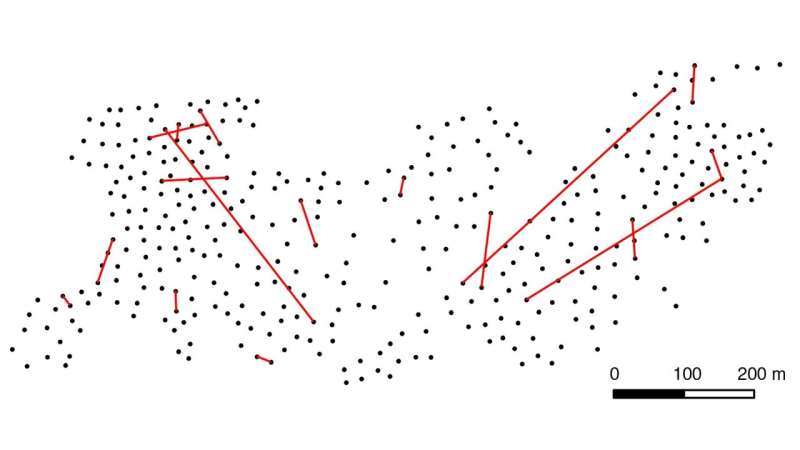This article has been reviewed according to Science X's editorial process and policies. Editors have highlighted the following attributes while ensuring the content's credibility:
fact-checked
trusted source
proofread
New research into the secrets of the forest: Finnish tree population is made up of families and neighborhoods

The trees in the forest are not just a random group. Fascinating facts reveal pine tree family relationships. The pollen that floats in the air can spread for hundreds of kilometers, but the offspring are usually found in the neighborhood.
These new findings, now published in the Peer Community Journal, are also important for forest management.
The trees in the forest are not a randomly organized group, but they make up families and neighborhoods.
Scots pines (Pinus sylvestris) do not grow completely randomly throughout the forest, but remain in the vicinity of their close relatives. This was the conclusion of a new study on the relationships of Finnish forest pines.
The average distance between offspring and parent is 54 meters. This result is probably due to the fact that seeds disperse over a shorter distance than pollen. Indeed, pollen can spread over distances of up to hundreds of kilometers, which can be unnerving for a terrace or car washer, but is an effective promoter of gene flow and, as a result, of a wide gene pool in the Scots pine range.
Despite the long flight distance of pollen, pine reproductive partners are likely to be found among the 2,500 nearest pine trees (the so-called neighborhood size), which corresponds to a good hectare in a Finnish commercial forest.
This year is expected to be particularly rich in pine blossom. Pine is wind-pollinated, meaning that pollen is carried from the male strobili to the female strobili by the wind. Once pollination has taken place, the pine seeds begin to develop inside the pine cone. The seeds are not fully developed until two years later, when they break off from the pine cone and float to the ground.
Pine seeds can also be carried by animals, and this is how a new pine seedling ends up in its growing site. Like humans, pine trees begin to reproduce at around 20 years of age. An individual pine tree has both female and male reproductive organs and self-pollination occurs, but the resulting highly inbred seeds are of low viability.
Although the offspring do not usually travel very far from the mother tree, the forest is still a mosaic of families. The abundance of reproductive pine trees means that individual trees cannot dominate, and there also are many trees from completely different families among close relatives.
"In the past, Scots pine relationships have been studied in small, isolated populations at the edges of their range, where clusters of relatives are more distinct. We now have confirmation that the kinship structure is also present in a very large and continuous pine forest," says Associate Professor Alina Niskanen from the University of Oulu, Finland.
The new data on the dispersal distance and relatedness structure of pine are important for forest management. They can be used, for example, in deciding an appropriate distance between seed trees in terms of avoiding inbreeding caused by relatedness.
The study used forest plots resulting from natural regeneration, where seed trees had been left after felling. The results thus describe a typical situation in Finnish forest management, which arises after seed tree felling, when both seed trees and trees in the surrounding areas seed a new generation of pine trees.
For the study, nearly 500 adult pine trees were selected from the Natural Resources Institute Finland's Punkaharju research forest in Finland and relatedness between them was determined using genome-wide genetic data.
From the distances between individuals with different degrees of relatedness, an estimate of the average distance between offspring and parent and the size of the neighborhood was obtained.
More information: Alina K. Niskanen et al, Does the seed fall far from the tree? Weak fine-scale genetic structure in a continuous Scots pine population, Peer Community Journal (2024). DOI: 10.24072/pcjournal.413
Provided by University of Oulu

















